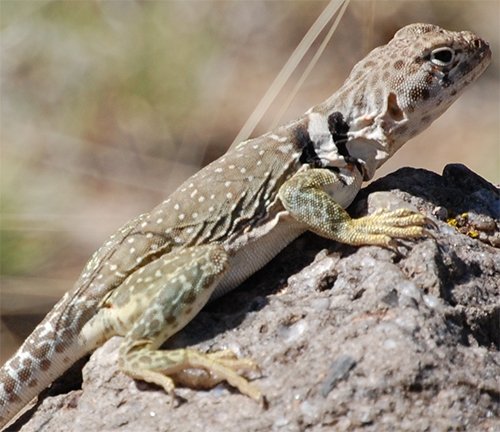A Colorful Collar!
Hovenweep National Monument, CC BY 2.0, via Wikimedia Commons
Crotaphytidae
by Inspector Barry Mins on May 24, 2022Hey kids, welcome back to our series on the mysteries of created kinds!
This week we move from the mountains to the deserts of the American southwest and northern Mexico. And no rodents this week. Your mom is probably happy about that. Instead, we’re looking for a speedy little lizard.

This kind of lizard is quite small, with the larger species just over a foot in length, but surprisingly quick for their size. One species has been observed running at speeds of over 12.6 km. per hour.1 That’s almost eight miles an hour. For reference, the average human adult runs about ten miles an hour. For a lizard about a fifth as tall as a human, that’s running fast! To hit that top speed, they will sometimes run on their hind legs only.
Like other lizards, this kind needs to warm up to start their day. As these lizards warm up, their heart rate increases, and they breathe faster and consume more oxygen.2 These changes caused by increased body temperature allow the lizard to flee predators or chase prey much more quickly.3 Too much heat is bad for them, though, and they spend most of their day sheltering in rocks, burrows, and under plants.4 These lizards, however, are better adapted to their desert homes than those that like similar habitats but prefer cooler temperatures.5 Males and females tend to prefer different microhabitats within their home range, with males preferring to spend more time in cover and on harder substrates than females. 6
Males of this kind will stake out territories and defend them aggressively against males of the same species. However, if a male stakes out a neighboring territory, the two males will be less aggressive towards one another than they will be towards an unknown lizard.7 Males fight by exhibiting for other nearby males, hoping to show they are tougher. The male who wins these confrontations tends to be the male with the harder bite force.8 The males are often more colorful than the females, making them more vulnerable to predators.9
Has anyone figured it out yet? This week’s kind is the Crotaphytidae, a group of reptiles commonly called the collared lizards. Some males have colorful rings or “collars” on their necks.
Try out this fun crossword!
Clue
Your clue for the next week is:
Next week, we move over to Africa where we are looking for a snake that gets its name . . . checks notes . . . from a digging mammal?
Ask a Question
Have you ever had a question about created kinds but didn’t know who to ask? Have you ever wanted to learn more about your favorite kind? Well, now you can! You can ask me, Inspector Barry Mins, a question! Have your parents help you fill out this form, and you might get your question answered in my column! If you have any questions about created kinds, feel free to send them my way!
Footnotes
- J. F. Husak and S. F. Fox, “Field use of maximal sprint speed by collared lizards (Crotaphytus collaris): compensation and sexual selection,” Evolution 60, no. 9 (2006): 1888–1895.
- W. R. Dawson and J. R. Templeton, “Physiological responses to temperature in the lizard Crotaphytus collaris,” Physiological Zoology 36, no. 3 (1963): 219–236.
- S. R. Crowley, and R. D. Pietruszka, “Aggressiveness and vocalization in the leopard lizard (Gambelia wislizennii): the influence of temperature,” Animal Behaviour 31, (1983): 1055–1060.
- K. N. Ivey, M. Cornwall, H. Crowell, N. Ghazian, E. Nix, M. Owen, M. Zuliani, C. J. Lortie, M. Westphal, and E. Taylor, “Thermal ecology of the federally endangered blunt-nosed leopard lizard (Gambelia sila),” Conservation Physiology 8, no. 1 (2020).
- A. L Angert, D. Hutchinson, D. Glossip, and J. B. Losos, “Microhabitat use and thermal biology of the collared lizard (Crotaphytus collaris collaris) and the Fence Lizard (Sceloporus undulatus hyacinthinus) in Missouri Glades,” Journal of Herpetology 36, no. 1 (2002): 23–29.
- G. E. Garrison, J. C. Z. Gebin, J. F. Penner, F. E. Jacobson, M. A. Eifler, and D. A. Eifler, “Intraspecific variation in habitat use and movement in long-nosed leopard lizards (Gambelia wislizenii) from the Alvord Basin, Oregon,” The Southwestern Naturalist 62, no. 3 (2017): 187–192.
- J. F. Husak and S. F. Fox, “Adult male collared lizards, Crotaphytus collaris, increase aggression towards displaced neighbors,” Animal Behaviour 65, (2003): 391–396.
- J. F. Husak, A. K. Lappin, S. F. Fox, and J. A. Lemos-Espinal, “Bite-force performance predicts dominance in male venerable collared lizards (Crotaphytus antiquus),” Copeia 2 (2006): 301–306.
- J. F. Husak, J. M Macedonia, S. F. Fox, and R. C. Sauceda, “Predation cost of conspicuous male coloration in collared lizards (Crotaphytus collaris): an experimental test using clay-covered model lizards,” Ethology 112, (2006): 572–580.
- © 2025 Answers in Genesis
- Privacy Policy
- Contact
- About


